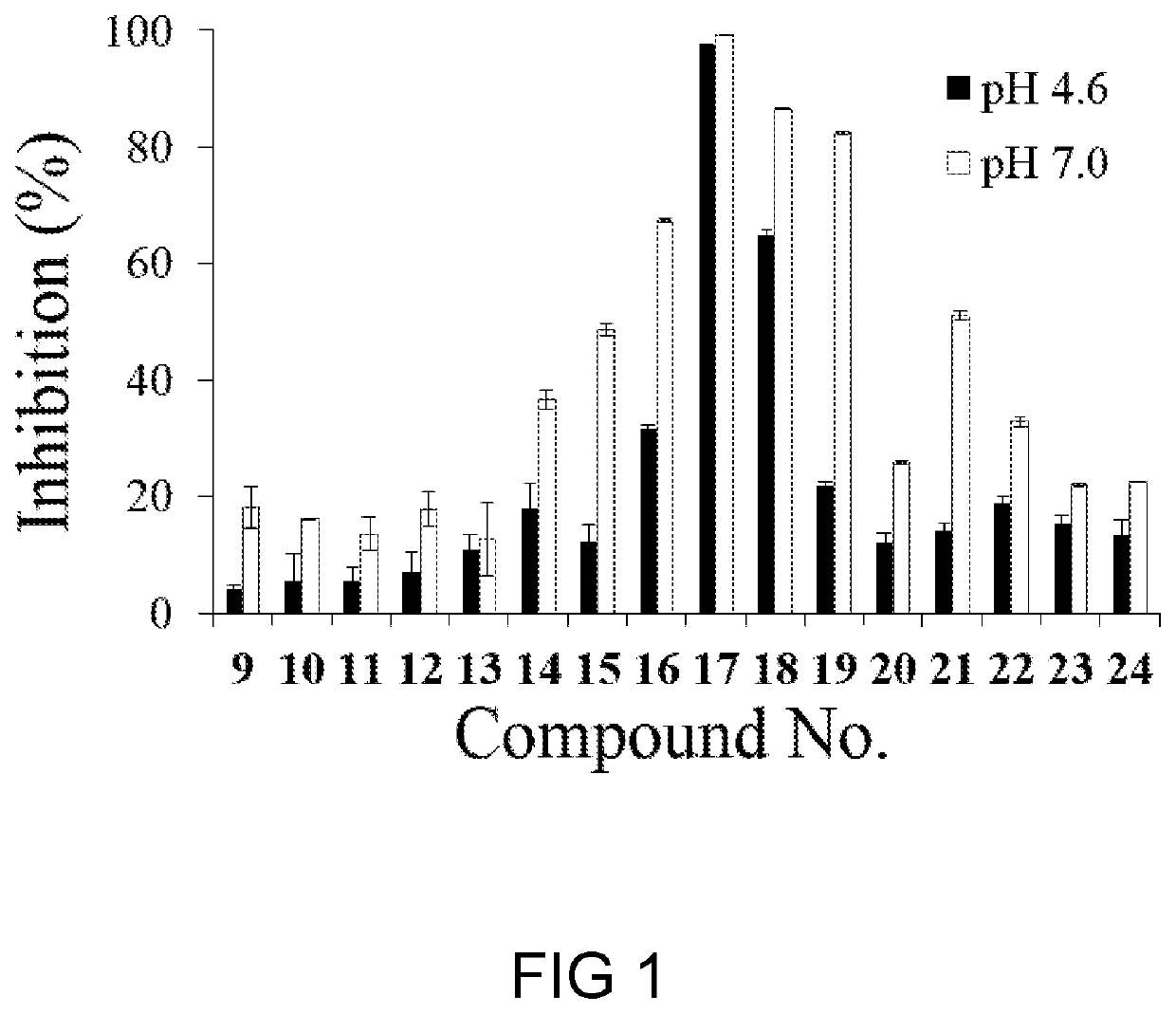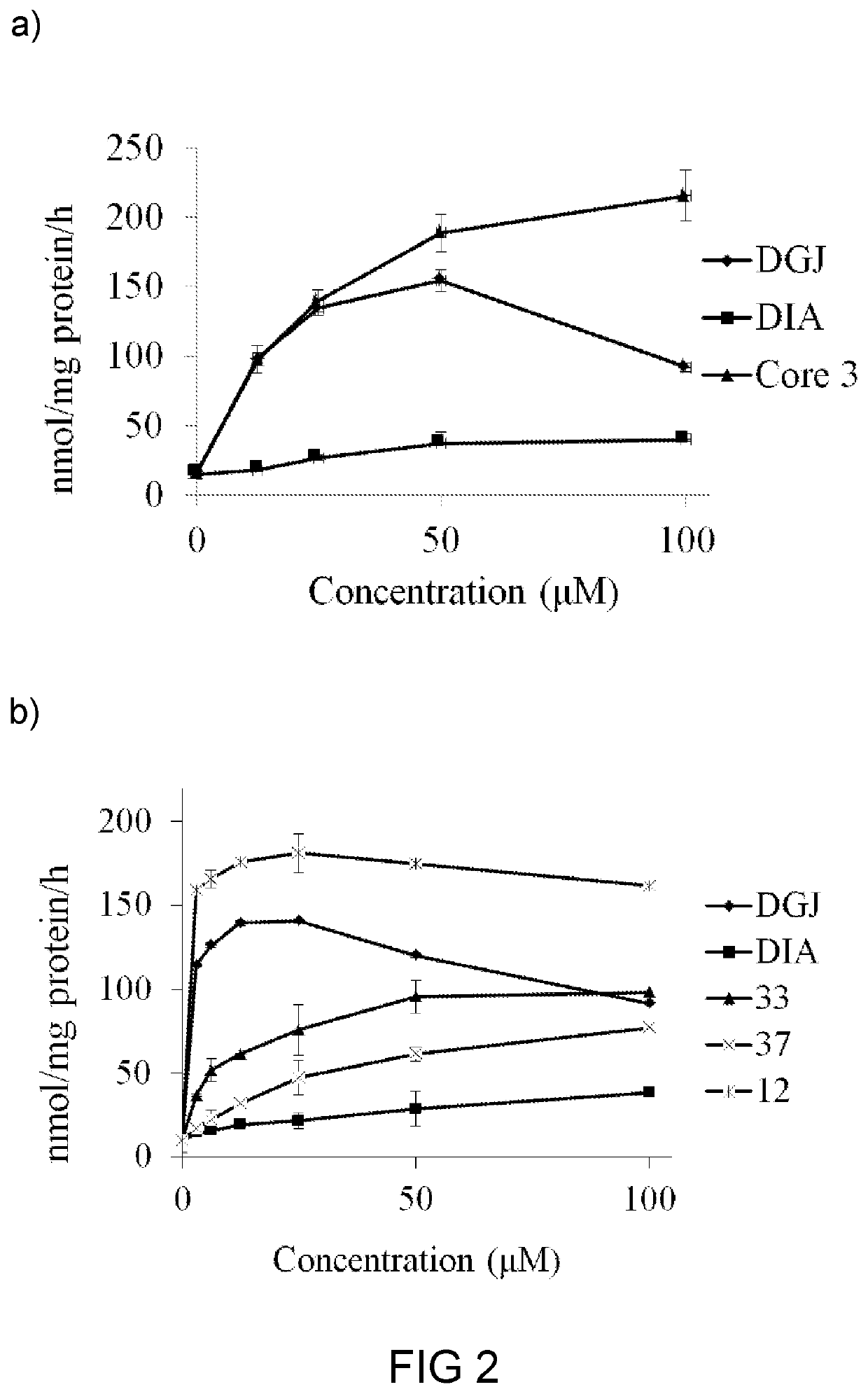Treatment of Fabry disease
a technology of chemical chaperones and enzymes, applied in the field of fabry disease treatment, can solve the problems of inability to cross the blood-brain barrier, high cost, inconvenience, etc., and achieve the effect of treating or prophylaxis of fd
- Summary
- Abstract
- Description
- Claims
- Application Information
AI Technical Summary
Benefits of technology
Problems solved by technology
Method used
Image
Examples
example 1 preparation
and Characterization of Compounds 9 to 37
1.1 Synthesis of Compounds 9 to 24
[0121]
[0122]In this example, a total of 16 unnatural stereoisomers of amino-DMDP (or ADMDP), i.e., compounds 9 to 24, were prepared from eight corresponding pyrrolidine-type chiral tri-O-benzyl cyclic nitrones in accordance with the method described by Tsou et al (Tetrahedron 2009, 65, 93). Each cyclic nitrones acts as a precursor to generate two desired ADMDP-like products bearing the 2,3-cis and 2,3-trans configuration, dependent on the chemical transformations of the cyclic nitrones used. Scheme 1 provides a typical process for synthesizing compounds 17 and 18. Specifically, the highly diastereoselective nucleophilic addition of TMSCN to cyclic nitrone 25 in methanol at 50° C. gave the 2,3-trans isomer 26 as a major product (78%, dr≥20 / 1), which was then converted directly to 17 in good yield (60%) via a reductive-N-protection as well as O-Bn deprotection. On the other hand, inversion of the C-2 nitrile gr...
example 2
Characterization of Chaperon Effects of Compounds 17, 33, and 37
[0174]Based on the finding in example 1, compounds 17, 33, and 37 were chose for further studies, particularly for their respective efficacy as a molecular chaperon toward mutateda-Gal A. Specifically, compound 17, 33 or 37 was subject to chemical chaperoning study toward FD patient cell lines N215S with certain mis-sense mutations, and results are illustrated in FIG. 2.
[0175]Surprisingly, compound 17 was able to enhance the mutant α-Gal A activity in a wide range of concentrations (from 0 to 100 μM). The addition of any of the compounds 17, 33, and 37 (100 μM) to N215S patient lymphocytes led to significant increases in α-Gal A activity (more than 10- and 18-folds increases for compounds 17 and 33, respectively), as compared with that of the control untreated cells (FIG. 2). Further, the chaperoning effect of 17 or 33 was better than that of DGJ or DIA. Specifically, the chaperoning effect of 33 was about 4-fold more p...
example 3
Chaperon Effects of Compounds 28 and 29
[0182]Two analogues of compound 17, including compounds 28 and 29 were prepared in accordance with procedures described in example 1.2, and their effects toward rh-α-Gal A as compared with that of compound 17 were investigated by direct measurement of the enzyme activity; and by thermal shift study.
[0183]It was found that the inhibition activities of 17, 28, and 29 against rh-α-Gal A at pH 7.0 were 0.053, 9.5, and 22.1 μM, respectively.
[0184]The thermal shift study, which is a fluorescence-based thermal denaturation assay, was employed to see if any of compounds 17, 28 or 29 improved the stabilization of rh-α-Gal A by measured the melting temperature (Tm) of the enzyme under various conditions. Results are summarized in Table 5 and FIG. 4.
[0185]The Tm of rh-α-Gal A was 51.3° C. at neutral pH (7.0), and was 54.8° C. at acidic pH (4.6), which indicated that rh-α-Gal A was relatively unstable at neutral pH. In the case when compound 17 was include...
PUM
| Property | Measurement | Unit |
|---|---|---|
| pH | aaaaa | aaaaa |
| pH | aaaaa | aaaaa |
| pH | aaaaa | aaaaa |
Abstract
Description
Claims
Application Information
 Login to View More
Login to View More - R&D
- Intellectual Property
- Life Sciences
- Materials
- Tech Scout
- Unparalleled Data Quality
- Higher Quality Content
- 60% Fewer Hallucinations
Browse by: Latest US Patents, China's latest patents, Technical Efficacy Thesaurus, Application Domain, Technology Topic, Popular Technical Reports.
© 2025 PatSnap. All rights reserved.Legal|Privacy policy|Modern Slavery Act Transparency Statement|Sitemap|About US| Contact US: help@patsnap.com



